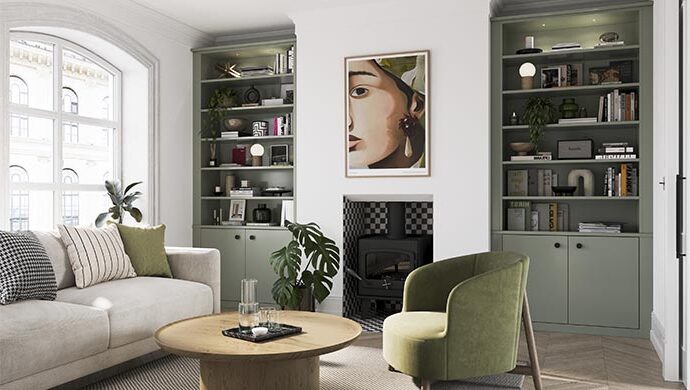Contemporary interior design is characterized by its clean lines, minimalist aesthetic, and emphasis on functionality and comfort. Rooted in modern principles, it incorporates current trends while maintaining timeless appeal. Whether you’re designing a new home or refreshing your existing space, contemporary design offers versatility and sophistication that works for any room.
In this guide, we’ll explore the key features, design principles, and practical tips to help you master contemporary interior design.
What is Contemporary Interior Design?
Contemporary interior design reflects the present-day styles and trends, evolving over time to incorporate new ideas and innovations. Unlike modern design, which refers to a specific historical style, contemporary design is ever-changing and dynamic.
Key characteristics of contemporary interior design include:
- Simplicity and Minimalism: Focuses on clean, uncluttered spaces with a “less is more” approach.
- Neutral Color Palettes: Often features whites, grays, and beiges with occasional pops of color.
- Open Layouts: Promotes spaciousness and flow between different areas of the home.
- Focus on Functionality: Prioritizes furniture and decor that serve practical purposes while being aesthetically pleasing.
- Emphasis on Light: Uses natural and artificial light to enhance the space and highlight key design elements.
Key Elements of Contemporary Interior Design
1. Neutral Color Schemes
Neutral tones form the foundation of contemporary interiors, creating a calm and cohesive look.
- Base Colors: White, beige, gray, and taupe dominate walls, floors, and larger furniture pieces.
- Accent Colors: Add pops of vibrant hues like mustard, navy, or teal through pillows, rugs, or artwork.
- Monochromatic Layers: Combine various shades of the same color for depth and sophistication.
2. Clean Lines and Geometric Shapes
Contemporary interiors emphasize straight, clean lines and geometric forms.
- Furniture: Opt for pieces with sleek, streamlined designs—no ornate details or excessive embellishments.
- Architectural Features: Use simple, symmetrical elements like square or rectangular windows and doors.
- Decor: Incorporate geometric patterns in rugs, cushions, or wall art for visual interest.
3. Natural Materials and Textures
To balance the minimalist aesthetic, contemporary design often incorporates natural materials and textures.
- Wood: Use light or medium-tone wood for flooring, furniture, or accent pieces.
- Stone: Add marble, granite, or concrete for countertops, backsplashes, or feature walls.
- Fabrics: Incorporate natural fibers like linen, cotton, or wool for a soft, organic feel.
4. Open Spaces and Flow
Contemporary interiors embrace open layouts that enhance natural light and create a sense of spaciousness.
- Open-Plan Living: Combine living, dining, and kitchen areas into one cohesive space.
- Minimal Furniture: Avoid overcrowding the room—leave plenty of negative space for a clean look.
- Large Windows: Maximize natural light by opting for floor-to-ceiling windows or glass doors.
5. Functional and Stylish Lighting
Lighting is both a functional and decorative element in contemporary design.
- Ambient Lighting: Use recessed lights, LED strips, or flush-mounted fixtures for general illumination.
- Task Lighting: Include pendant lights, floor lamps, or table lamps for focused lighting.
- Accent Lighting: Highlight artwork, architectural details, or statement furniture with spotlights or wall sconces.
Furniture and Decor Ideas
Contemporary interior design thrives on simplicity and practicality, with each piece carefully chosen to complement the overall aesthetic.
Furniture Tips
- Sofas and Chairs: Select low-profile, neutral-toned seating with clean lines.
- Coffee Tables and Storage: Opt for minimalist designs with hidden storage to maintain an uncluttered look.
- Dining Tables: Choose glass, wood, or metal finishes for a sleek and modern appeal.
Decor Tips
- Art and Sculptures: Use large-scale abstract paintings, framed photography, or modern sculptures to create focal points.
- Mirrors: Incorporate mirrors to reflect light and enhance the sense of space.
- Rugs and Textiles: Add textured area rugs, throw pillows, and curtains in neutral or monochromatic shades.
Best Color Combinations for Contemporary Design
Creating a cohesive color palette is key to achieving a contemporary look. Below are some popular combinations:
| Base Color | Accent Color(s) | Highlights | Example Rooms |
|---|---|---|---|
| White | Black, Gray | Metal finishes (chrome) | Living rooms, kitchens |
| Beige | Navy Blue, Gold | Warm wood tones | Bedrooms, offices |
| Gray | Yellow, Mustard | Textured fabrics | Living rooms, dining rooms |
| Taupe | Teal, Olive Green | Natural greenery | Bathrooms, entryways |
Practical Tips for Implementing Contemporary Design
- Start with a Neutral Base: Paint walls in white or gray and select neutral-toned furniture for a cohesive foundation.
- Focus on Quality Over Quantity: Choose fewer, high-quality pieces rather than overloading the space with decor.
- Embrace Natural Light: Position mirrors or light-colored furniture to reflect sunlight and brighten the room.
- Layer Textures: Combine smooth surfaces (glass, metal) with soft fabrics and natural materials for depth.
- Declutter Regularly: Keep surfaces clear of unnecessary items to maintain the clean aesthetic.
Pros and Cons of Contemporary Interior Design
| Pros | Cons |
|---|---|
| Timeless and versatile style | Can feel cold or impersonal without warmth |
| Works well in any space, large or small | Requires upkeep to maintain minimalism |
| Focus on functionality and comfort | May lack character if overly simplified |
Final Thoughts
Contemporary interior design offers a perfect balance of style and functionality, creating spaces that are modern, inviting, and adaptable. By focusing on clean lines, neutral colors, and quality materials, you can transform your home into a sleek, timeless retreat. Whether you’re redesigning a single room or your entire home, contemporary design ensures an aesthetic that feels fresh and current while standing the test of time.
Start small, experiment with textures and colors, and embrace the elegance of simplicity. With these ideas and tips, you’ll be well on your way to achieving a contemporary interior design that reflects your personality and enhances your living space.
Ready to create a contemporary masterpiece? Start planning today and bring your vision to life!
